|
|
Finance Crisis: Who Wants to be a Lender of Last Resort?
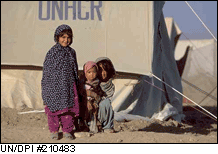 |
|
By late 1998, the near-meltdown of the international financial structure had rattled the leaders of the free world. When the G-7 finance ministers met to discuss the risks of unbridled capital flows and the possibility of a new 'financial architecture', it reminded many observers of an earlier discussion on reforming the global financial system. |
| |
At the urging of the Brandt Commission in North-South, an economic summit of leaders from developed and developing nations convened in Cancun in late 1981 for the International Meeting on Cooperation and Development. As noted in the section on Global Negotiations, it was the first, and only, meeting of its kind.
|
| |
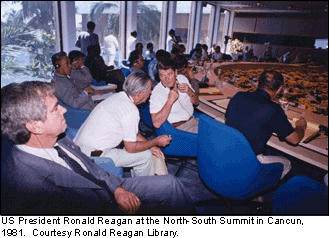 |
| |
National leaders discussed international development issues, but the conference lasted just two days and no action or follow-up was initiated. To keep the momentum going, the Brandt Commission issued a second report in 1983, Common Crisis, which proposed expanding the role and resources of the IMF and World Bank, and creating a new framework for international finance and trade. Common Crisis also urged the community of nations to ensure greater bank supervision and regulation in developing countries, while requiring more accountability from international financial institutions.
What is needed, said the Brandt Commission, is a global institution charged with balancing the private sector with the public interest, to mitigate shortfalls in development finance and ensure orderly and sustainable growth. Brandt's early version of this idea was twofold: the creation of a World Development Fund and a Development Advisory Body. |
| |
| At present, most aid to developing nations is simply an extension of credits that developed countries use to promote the export and purchase of their capital goods. This gives poor nations an ability to pay for imported goods, but not to generate additional capital. A sustainable source of external financing is needed to ensure that local currency expenditures are not soaked up by inflation and balance-of-payments shortfalls. |
|
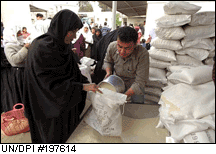 |
|
This source of development finance could come from a variety of untapped 'universal' sources, including fees on international corporations, international airline tickets, maritime transport, ocean fishing, satellite parking spaces, electromagnetic spectrum use, arms trafficking, environmental pollution, foreign currency trades, hedge funds, and derivatives.
As a start in this direction, the Brandt Commission proposed a:
"World Development Fund – with universal membership, and in which decision-making is more evenly shared between lenders and borrowers, to supplement existing institutions and diversify lending policies and practices. The World Development Fund would seek to satisfy the unmet needs in the financing structure, in particular that of program lending. Ultimately it could serve as a channel for such resources as may be raised on an universal and automatic basis" (N-S, 255).
In addition, the Brandt Commission saw the need for a high-level body to monitor and coordinate international development. The Development Advisory Body would be a small 'brain trust', an independent group without executive status. It would monitor and evaluate the work of the different international agencies in the field of development, and report on their effectiveness to governments and the UN General Assembly and its organs. Its aim would be to: "streamline the institutions, to define their objectives more clearly, and to achieve them more economically and effectively." It would be "a body of 12 members: a third of the members would be citizens of developing countries, a third would be from the industrialized countries and the remaining third selected for their experience and independent judgment" (N-S, 261).
They would also report to the public and be open to public input. |
| |
 |
|
Nothing came of these ideas in the 1980s. In 1989, Willy Brandt asked Ingvar Carlsson and Sir Shridath Ramphal to convene an Independent Commission on Global Governance. After Brandt died in 1992, the new Commission deliberated and issued a 1995 report, Our Global Neighborhood. The Global Governance Commission expanded the idea of a Development Advisory Body, calling for a new international group to manage economic interdependence. |
|
This new international financial body needn't be a large bureaucracy but a small council, making it more representative and flexible than the World Bank or the International Monetary Fund. This new council, which some have likened to a Global Economic Ministry, could provide oversight and advice on the international coordination of policies, specifically to:
- Monitor the state of the international economy
- Anticipate monetary and financial crises
- Track currency exchange rate stability
- Take the risk out of international financial flows
- Provide a long-term policy framework for sustainable development
- Secure consistency between the major international organizations
- Register input from regional organizations
- Build consensus between governments on new global economic policies
This type of coordination for the international economy is still lacking. A new democratic international structure, representing the interests of all people, would face many complex issues. Regulation – tighter controls on currency movements – is especially needed in international investing. Fair competitive practices must be ensured and monopolies restricted at the global level. At the same time, global financial institutions and corporations must be made more accountable to the public interest. Global safeguards are also required to prevent capital flight, fraud, money laundering, insider trading, and gridlock in financial markets. Without a responsible world authority to oversee speculative money trading, all nations, and developing economies especially, are at the mercy of erratic changes in capital flows, interest and exchange rates, and inflation.
The flexible exchange rate system, the world's economic 'non-policy', has been in effect for more than thirty years. To cope with cyclical swings in international capital flows under this arrangement, developing nations have adopted surrogate means of stabilizing their currencies to prevent financial panic. Some nations 'dollarize' – that is, they use actual US dollars for their currency. Other nations maintain a fixed exchange rate by linking their currency at parity with a strong foreign economic unit, usually American dollars. Still others prefer capital controls – a strict ban on currency trading during economic crises. |
| |
| None of these are permanent solutions, simply ways of avoiding the volatility that plagues free-floating currencies in a disorderly international system. Without a sovereign economic guarantor at the global level, the US Federal Reserve assumes the unofficial role of arbiter of global interest rates and currency values. Staking a nation's economic future to the strength of the US dollar and the monetary decisions of the US Central Bank has been a mixed blessing. Surrogate measures to ensure predictable exchange rates – dollarization and currency pegs – have had encouraging results in countries such as Ecuador, but have been disastrous in places like Argentina. |
|
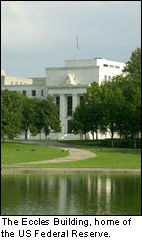 |
| |
The lack of global oversight is even more troublesome now than in 1983, when Brandt warned:
"The international community has made little headway in tackling its most serious problems which begin in the strained system of international economic relations and result in additional burdens on many developing countries. Prospects for the future are alarming. Increased global uncertainties have reduced expectations of economic growth even more, and the problem of managing the international imbalances of payments is increasing the threat of grave crises in international finance. We have serious doubts as to whether the existing world machinery can cope with these imbalances and the management of world liquidity and debt" (CC, 2).
These concerns loom larger than ever. What happens when a country's foreign currency reserves are less than the amount due on its debts? Who does a country turn to when it is broke? Nations that cannot derive their liquidity from private markets seek relief from the world's lender of last resort, the International Monetary Fund.
In return for a loan from the IMF, a poor country agrees to a series of conditions. When the Fund insists that a debtor nation raise interest rates, cut spending, raise taxes, and protect its currency – sometimes through devaluation – these measures often make the local situation worse. Property values slump, industrial production suffers, national reserves are depleted, and state assets are sold. In many cases, IMF austerity measures have contributed to deep recession, declining living standards, civil unrest, and even the fall of governments, as occurred in Argentina in late 2001. It's no secret that IMF conditionality serves the G-7's foreign policy interests over the interests of poor people in indebted nations. IMF restrictions are basically an attempt to restore the trust and confidence of the global market by demonstrating that a defaulting borrower is compliant and willing to cooperate with the global monetary and financial machinery, making it more attractive to international investors.
A practice known as 'moral hazard' was behind the multibillion dollar rescue operations of the 1990s. As a global financial rescue authority, the G-7 made it easy for risk-taking banks and high-stakes financial institutions to get paid off with public monies when their investments in emerging economies ran into trouble. |
| |
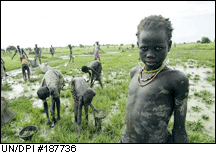 |
|
In each debt liquidation, IMF money simply passed through the hands of the debtor countries on its way to the creditors. These creditors – the international banks and brokerage houses – were the same ones that had rushed to make speculative investments in the first place, then pulled their money out, leaving behind impoverished and ruined economies. |
| |
Under this arrangement, lending and borrowing nations both end up losing. On one hand, when taxpayers from the Group of Seven nations pay for IMF bailouts, it creates more debt for their governments. On the other hand, the loans to developing nations are for debt repayment only, not targeted for domestic development, ensuring that the local cycle of borrowing, debt, and poverty is perpetuated. The sole beneficiaries of these mega-bailouts are the international banks and security houses, which are, in effect, extracting revenue from the boom and bust cycles of poor nations.
The IMF has been searching for a different way to aid indebted nations without rescuing private creditors. In 1999, the Fund offered pre-approved credit lines to developing nations that promise to follow strict economic and social policies to shield them from investor panic. The program never got off the ground. Developing nations would not agree to these new loan offers, since to accept the new credit line might send a signal to foreign investors that the recipient nation had underlying economic weaknesses.
To provide some order to the messy business of sovereign default and avoid scaring investors away from emerging markets, the IMF announced in late 2001 that it was creating a new framework for the resolution of debt crises between creditors and debtors. The new restructuring plan would be similar to US bankruptcy law. In return for promising to adopt new fiscal policies to prevent future debt crises, developing nations would be afforded legal protection from private creditors. Rather than a judgment imposed on a defaulting borrower by lenders, there would be a negotiated settlement for debt restructuring. The way it is outlined, however, this plan would entail a major conflict of interest for the IMF. As the bankruptcy arbiter, major financial creditor, and principal economic advisor for a defaulting nation brought before the global debtor's court, the IMF is proposing to play the roles of judge, prosecuting attorney, and star witness – hardly a fair or objective situation.
Since the Cancun Summit in 1981, the G-7 nations have strongly opposed changes to the existing superstructure of international finance. Now, those nations are discussing global reforms.
After the debacle in Asia and Russia, the G-7 began to push for better corporate accounting, more bank supervision, increased access to offshore banking, and new regulation of hedge funds. |
| |
| The G-7 also explored the possibility of creating a fund to underwrite the risk of the financial industry in making investments in emerging markets. Private insurance would be guaranteed before foreign investments are made, rather than after they turn bad. In the case of default, creditors could collect their money directly, without having to go through the IMF. |
|
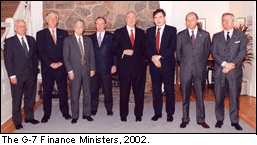 |
| |
In April 2002, at the urging of the United States Treasury Department, the G-7 nations took this idea further, proposing that markets could resolve cases of sovereign debt default without a private or public backup fund. Borrowing nations would simply agree to contingency clauses in their bond contracts with investors that would guarantee orderly debt repayment procedures. With the steps for payments stoppage, restructuring, and arbitration clearly spelled out in advance, the process of sovereign default would be far less chaotic.
The G-7 plan has some major flaws, however. While the new arrangement would increase the investment certainty for creditors, it is likely to produce greater uncertainty for borrowers. Developing countries have already expressed the fear that these debt restructuring clauses would indicate to the world market that their economies have been flagged as special risks, which would encourage higher interest rates on new bonds and discourage the very foreign investment that the contingency plan was intended to attract. In addition, these restructuring clauses would apply only to new debt issues, not to existing debt, which would still be subject to fractious resolution with creditors in case of default. Finally, the clauses would contain no provisions for the additional aid that would obviously be required to help a defaulting nation pay off its contingency agreement.
Though many would like the private sector to take a pro-active part in debt crisis resolution, financial institutions themselves have balked. Since the Russian monetary crisis, the emphasis in financial circles has been on risk management. Bankers and fund managers are all checking and rechecking their exposure and protective 'firewalls' against monetary and political risk in developing nations. Financial institutions have expressed little willingness to act as a lender of last resort or insure their risks in emerging markets as long as those economies lack the economic and legal infrastructure to protect overseas investments. |
| |
 |
|
Another proposal is to link repayments on loans to commodity prices. This has the virtue of spreading the risk of default between borrowers and lenders. That would be a positive development. On one hand, as the Brandt Reports noted, "more stable prices would be beneficial to exporting countries by helping to maintain foreign exchange earnings and to facilitate fiscal planning and economic management" (N-S, 148). On the other hand, involvement of lenders in these commodity price stabilization measures would add greater responsibility to their lending practices. |
| |
An updated version of the Common Fund, proposed by the Brandt Commission, would be useful in this regard. It would be a pool of money that would finance stocks and other investments to help the production, processing, and marketing of commodities. The Common Fund would support international commodity agreements, and provide coordinated financing of commodity development policies related to market stabilization. Guaranteed by banks and financial institutions, this fund could provide a buffer for commerce and trade during the next national or regional economic meltdown.
In the Latin debt crisis, international banks held the debts of developing countries and paid the bulk of the bill. In the Asian debt crisis, the debts were held by the banks, along with insurance companies, mutual funds, and pension funds held by millions of investors; the bailouts consisted mostly of G-7 public funds. Today, the world economy remains vulnerable in several areas:
- The banking and public debt crisis in deflationary Japan
- The inability of Malaysia, Singapore, Hong Kong, and most of Southeast Asia to recover from recession
- The deflationary slump in China
- The struggle with recession in Germany and the rest of Europe
- The currency devaluation in Argentina
- The trade deficit, debt burden, and recession in the United States
This is the short list of trouble spots. Deflation and currency devaluation in these or other regional flashpoints could set off another round of financial contagion, triggering a vicious round of panic and capital flight across the world. In a third debt crisis, the size of the rescue operation required would be enormous, especially if rich nations join poor ones among the victims. |
| |
| For the last twenty years, there was always one economy in the world strong enough to save the others from recession by buying their products. After the international bailouts of 1997-98, the US acted as the global consumer of last resort, lifting the world from an economic downturn. History is not likely to repeat itself. American consumers continue to borrow and spend, but not vigorously, due to their low rate of saving and mounting job losses. Consumer spending and business investment are also down across the world. Growth rates in world trade are at their lowest in two decades, increasing just 1% in 2001, down from a 12% increase in 2000. |
|
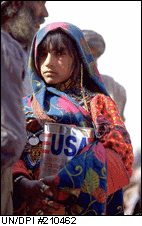 |
| |
Because it imports far more than it exports, America borrows more than $1.5 billion a day from abroad to cover the difference. The US trade foreign trade gap – and the current account defict that sustains it – pose a real danger to the world economy. A sudden shift in real exchange rates could cause foreign investors to pull their money out of the US in search of higher returns elsewhere, triggering a chain of events: a drop in the value of the dollar, a plunge in the American stock market, a rise in interest rates, and a slowdown in US economic growth, which would have adverse effects across the globe.
Each major economic region – the United States, Europe, and Japan – is in or near recession. Asia, Latin America, the Middle East, and Africa, which are heavily leveraged on the growth of the rich nations, are struggling with recessionary conditions. Though foreign corporations have increasing access to China's 1.3 billion consumers, Chinese purchasing power is relatively flat due to foreign competition and government restrictions on domestic trade and investment.
It is evident that the IMF and G-7 cannot continue to insure the capital that surges into and out of developing countries from the finance houses and banks of developed nations. After the Clinton era of 'moral hazard', there is a new attitude that capital lenders must assume full risk for their investments in developing nations, though it is unclear the extent to which the Bush administration will resist IMF intervention in major cases of sovereign debt default. Knowing that public emergency aid packages are less likely to be available, foreign investment banks vied with bondholders and fund managers for the most favorable terms on investment losses in the 2002 restructuring of $141 billion sovereign debt in Argentina, even as the IMF insisted that it be paid off before any private creditors.
Should this set a precedent, a higher volume of investment monies than public monies may be lost in the next major international currency crisis, leaving millions of insurance company, hedge fund, and mutual fund, and pension investors vulnerable. The wider threat is that a debt default like that in Argentina may not be contained to a single nation, leading to a major rolling selloff by investors around the world and encouraging more countries to default on their loans. Just as serious, the populist backlash and political instability which many nations experience during a domestic economic crisis can also make foreign investment in these countries far less attractive. |
| |
 |
|
In 2002, the Bush Administration proposed a new system of credit ratings through which developing nations may qualify for access to private markets. The strategy is that by imposing a sovereign debt standard upon new borrowers, providing markets an immediate indication of their credit-worthiness, developing nations would gradually decrease their dependence on international aid and increase economic growth. |
| |
Proponents of this idea maintain that establishing credit ratings on debt would force the governments of poor nations to create more disciplined financial structures, balance their budgets, ensure greater political transparency, create stronger legal systems, and increase the protection of property rights in order to win new investments from the private sector. 'Good economics' and 'good governance' would thus eliminate the need for a global financial safety net.
The problem with this proposal is that market standards for sovereign credit quality would favor a handful of developing nations over others. As foreign investors avoid the 'junk-grade' government debt issues of the poorest nations, only the wealthier developing nations would qualify for the new high-grade investment. Developing nations that do not score well on these development criteria will have to scramble for alternative sources of finance, if available, gradually widening the divide between the wealthier developing nations and the less developed.
The Bush proposal is, in effect, an attempt to deregulate the sovereign lending market. Ratings on the debt payment capabilities of developing nations would certainly reduce the risk for investors, but would also have a chilling effect on financial liquidity in developing nations too poor to qualify for new loans and investment. It seems ironic that the G-7 nations – led by the United States – are now blaming the World Bank and International Monetary Fund for forty years of failure in achieving the economic and political reforms necessary to reduce poverty in developing nations, without mentioning the role that private investment has played in increasing foreign ownership of government services and local safety nets, leaving poor nations vulnerable to unregulated speculation, recession, and macroeconomic shocks. While the G-7 calls – justifiably – for greater transparency and accountability on the part of the international public lending institutions, G-7 nations are still opposed to governmental or regulatory oversight of the vast private foreign exchange and investment markets. Even within their own countries, national regulators have scant information about global markets and the activities of international financial firms, and there is no global agreement as to what would constitute adequate national – let alone international – standards for economic and financial regulation.
This broad lack of regulation encourages investment capital to focus on financial diversification, rather than local economic development or global investment safeguards for emerging economies. The problem is the same as it was in 1980: how to get cautious investors to absorb their failed loans, without strangling the foreign capital needed for continued development in poor countries. A new regulatory framework for foreign investment and global financial management is needed. It is hardly surprising that governments, central banks, private banks, private creditors, and the IMF are all reluctant to take responsibility for default protection under the current competitive system. For all their worry about inflation and interest rates, the institutions of global monetarism have allowed personal and commercial debt to reach record levels all over the world, leaving them afraid to bet on volatile markets and unable to insure their investments in developing nations. |
| |
| No institution, nation, or bloc of nations can now engineer the kind of global machinery that is required for cooperative and sustainable international financing. Nor will sovereign debt reform be achieved through economic mechanisms that circumvent international law. "It will not be possible," Brandt predicted, "for any nation or group of nations to save itself either by dominion over others or by isolation from them. On the contrary, real progress will only be made nationally if it can be assured globally" (N-S, 268). |
|
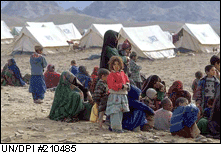 |
| |
The present arrangement in world money and finance is a high-stakes hazard, not just for people in developing nations, but for governments, banks, corporations, foreign creditors, and portfolio investors as well – an unacceptable threat on a planet which otherwise demonstrates great facility in the arts of creative financing, institutional restructuring, and enlightened diplomacy. For the risk to be spread evenly, with a minimum of damage, there must be political intervention at the international level – not by one, but all nations collectively.
The international community needs to end global financial instability and create an orderly economic structure. An integrated world economy requires that all nations help to establish and underwrite a world economic guarantor, a lender of last resort capable of restructuring sovereign debt and financing massive international payments shortfalls when the need arises. Without that capability, the global financial system remains its own worst enemy.
Part III proposes a democratic framework for a new global monetary system. |
| |
|
|
|
|
|
|
|

